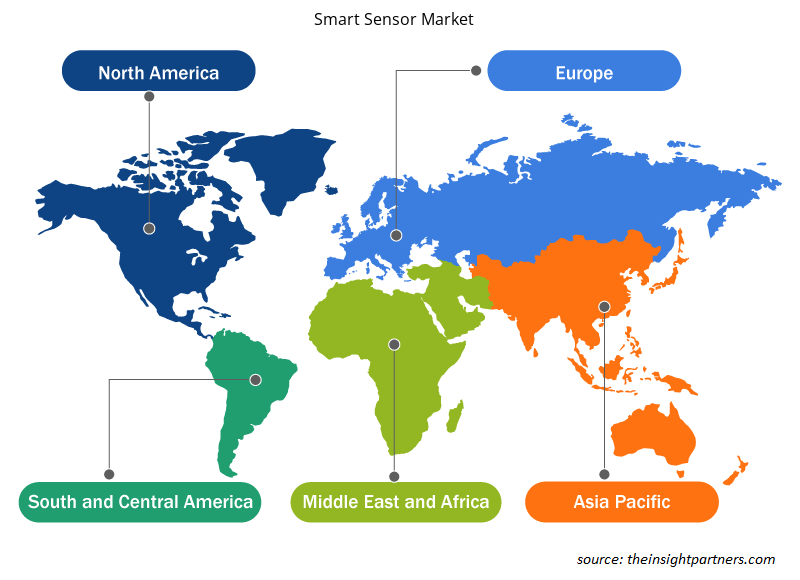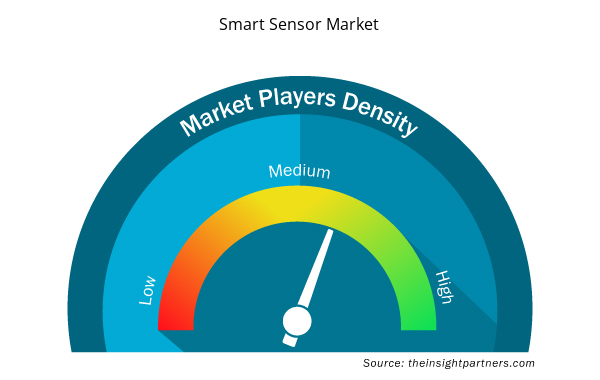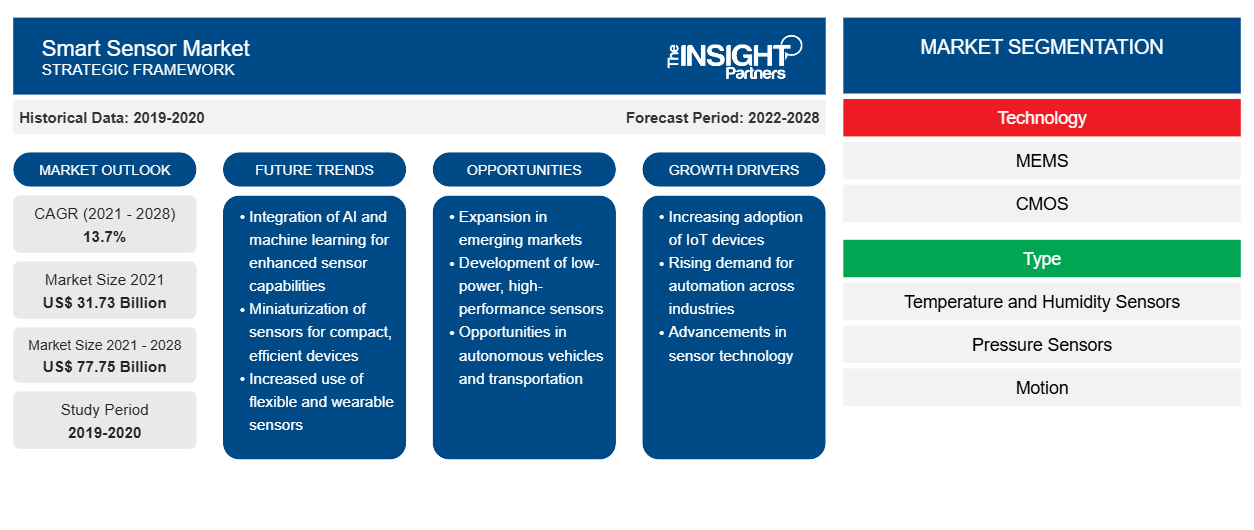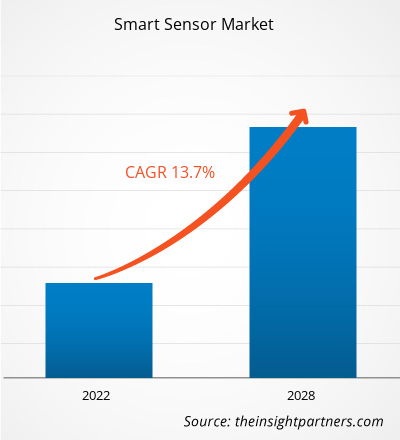Der Markt für intelligente Sensoren soll von 31.731,1 Millionen US-Dollar im Jahr 2021 auf 77.747,6 Millionen US-Dollar im Jahr 2028 wachsen. Zwischen 2021 und 2028 wird mit einer durchschnittlichen jährlichen Wachstumsrate von 13,7 % gerechnet.
Intelligente Sensoren sind schneller und genauer als herkömmliche Sensoren. Diese Sensoren sind kleiner und verbrauchen weniger Strom als herkömmliche Sensoren. Der Einsatz intelligenter Sensortechnologie in IoT-basierten Geräten und Unterhaltungselektronik sowie ihre Anwendung in den Bereichen Luft- und Raumfahrt und Verteidigung, Automobil, Biomedizin und Gesundheitswesen, Industrieautomatisierung, Gebäudeautomatisierung, Unterhaltungselektronik, Bildung, Robotik, Landwirtschaft und Transport haben in den letzten Jahren viel Interesse geweckt. Die zunehmende Nutzung intelligenter Sensoren in allen Anwendungsbereichen ist ein Schlüsselfaktor für den Anstieg des Marktes für intelligente Sensoren .
Angesichts zunehmender Sicherheitsbedenken steigt die Nachfrage nach intelligenten Sensoren in der Unterhaltungselektronik, was sich auf den Markt für intelligente Sensoren auswirkt. Verschiedene Sensoren, wie etwa Nachtsicht-IR-Sensoren, Geräuschsensoren oder Mikrofone und intelligente Toiletten, werden in der Heimautomatisierung eingesetzt. Unternehmen integrieren verschiedene Funktionen in ihre intelligenten Sensoren, wie etwa automatische Reinigung, automatische Spülung, Tanklecküberwachung, Wasserüberlaufschutz und Gesundheitsüberwachung. Lichter und Ventilatoren können mit einem automatischen System gesteuert werden, das Infrarot- oder Bewegungssensoren verwendet.
Darüber hinaus wächst mit dem sich ändernden Lebensstil und dem neuen modernen Lebensstandard die Nachfrage nach modularen Küchen mit integrierter Hausautomation exponentiell, was sich positiv auf den Markt für intelligente Sensoren auswirkt. Hersteller entwickeln synthetische sensorbasierte Geräte zur Überwachung von Vibrationen, Küchengeräuschen, Licht, Gas, Temperatur, Hitze sowie elektromagnetischer Temperatur und Lärm, wodurch der Markt für intelligente Sensoren wächst. Beispielsweise bietet Analog Devices, Inc. HMC1126 GaAs pHEMT-Sensoren an. Dabei handelt es sich um einen rauscharmen Verstärker, der in einem Bereich von 400 MHz bis 52 GHz arbeitet und in verschiedenen Anwendungen eingesetzt wird, beispielsweise in Mikrowellenradios, Very Small Aperture Terminals (VSATs), Testgeräten und 5G-Kommunikation.
Passen Sie diesen Bericht Ihren Anforderungen an
Sie erhalten kostenlos individuelle Anpassungen an jedem Bericht, einschließlich Teilen dieses Berichts oder einer Analyse auf Länderebene, eines Excel-Datenpakets sowie tolle Angebote und Rabatte für Start-ups und Universitäten.
- Holen Sie sich die wichtigsten Markttrends aus diesem Bericht.Dieses KOSTENLOSE Beispiel umfasst eine Datenanalyse von Markttrends bis hin zu Schätzungen und Prognosen.
Die intelligente Sensortechnologie hat zu rasanten technologischen Fortschritten bei Smartphones und tragbaren Geräten geführt. Automobilhersteller verlangen zunehmend nach intelligenten Sensoren, um Sicherheit und Komfort zu verbessern. Der Einsatz von drahtloser Technologie zur Überwachung und Steuerung von Sicherheitsgeräten, die mit intelligenten Sensoren ausgestattet sind, wird immer üblicher. Inmitten von COVID-19 bieten der Anstieg der Nachfrage nach tragbaren Geräten mit intelligenten Sensoren, die anhaltende staatliche Unterstützung für umweltfreundliches Bauen und vorausschauende Wartung den Akteuren auf dem Markt für intelligente Sensoren lukrative Möglichkeiten.
Die zunehmende Verbreitung von Smartphones hat das Wachstum des Marktes für intelligente Sensoren erheblich vorangetrieben. Zu den intelligenten Sensoren gehören beliebte Sensoren wie Bewegungs-, Positions-, Umgebungslicht-, Beschleunigungs- und Gyroskopsensoren . SAR-Sensoren (Specific Absorption Rate) verbessern die Konnektivität für eine breite Palette von drahtlosen Technologien wie 5G Sub-6/4G/Wi-Fi in Smartphones, Tablets und Laptops. SEMTECH, ein führender Halbleiterlieferant, bietet die Sensoren PerSeTM Connect, PerSe Connect Pro und PerSe Control an, die in verschiedenen Anwendungen wie Smartphones, Laptops, Tablets und Wearables eingesetzt werden können.
Viele Unternehmen entwickeln neue und fortschrittliche intelligente Sensoren, die Mikrocontroller in einem einzigen Paket kombinieren. Moderne Technologien wie KI (künstliche Intelligenz) und IoT ermöglichen diese Kombination in kleinen Verpackungen. Beispielsweise kann der BHA250 von Bosch Sensortec einen 32-Bit-Mikrocontroller mit einem 14-Bit-Beschleunigungssensor in einem 2,2 x 2,2 x 0,95 mm3 großen Paket kombinieren. Darüber hinaus hat das Unternehmen TE Connectivity Sensoren mit Steckverbindern integriert, um Funktionen auf kleinem Raum unterzubringen. Diese Entwicklungen in der intelligenten Sensortechnologie wirken sich positiv auf das Wachstum des Marktes für intelligente Sensoren aus. Mit dem Wachstum in der Unterhaltungselektronikbranche, beispielsweise bei intelligenten Getränkeautomaten, intelligenten Hausautomatisierungssystemen, einfachen Computern, digitalen Assistenten (wie Alexa) und tragbaren Geräten, ist die Nachfrage nach intelligenten Sensoren auf dem Markt für intelligente Sensoren gestiegen. Traditionelle Verbraucherprodukte wie Laptops, Smartphones und Fernseher übertreffen weiterhin die Erwartungen, da die Verbraucher weiterhin neue und aufkommende Produkte annehmen, darunter tragbare Geräte, sprachgesteuerte intelligente Lautsprecher und Smart-Home-Geräte.
Mehreren Studien zufolge werden in den kommenden Jahren zig Milliarden IoT-Geräte mit dem Internet verbunden sein, was große Auswirkungen auf den Markt für intelligente Sensoren haben wird. COVID-19 treibt die Strategien für urbane Resilienz und digitale Transformation voran, während sich Stadtverwaltungen an eine neue Realität anpassen.
Auswirkungen der COVID-19-Pandemie auf den Markt für intelligente Sensoren
Das Auftreten von COVID-19 hat die Notwendigkeit, die digitale Infrastruktur für die Fernüberwachung von Patienten zu nutzen, in den Mittelpunkt gerückt. Aufgrund der langsamen Entwicklung aktueller Virustests und Impfstoffe wurde festgestellt, dass ein größerer Bedarf an einer robusteren Krankheitserkennung und Überwachung der Gesundheit von Einzelpersonen und der Bevölkerung besteht, wozu tragbare Sensoren beitragen könnten. Obwohl der Nutzen dieser Technologie genutzt wurde, um physiologische Messwerte mit dem täglichen Leben und der menschlichen Leistungsfähigkeit zu korrelieren, ist es weiterhin notwendig, sie anzuwenden, um das Auftreten von COVID-19 vorherzusagen.
Die wachsende Nachfrage nach energiesparenden Geräten treibt die Nachfrage nach intelligenten Sensoren auf dem nordamerikanischen Markt für intelligente Sensoren in die Höhe. Unternehmen setzen zunehmend auf energieeffiziente Energiespargeräte, da das veränderte Szenario energieeffiziente Geräte und Produkte erfordert. Darüber hinaus ist die Nachfrage nach Sensoren auf dem Markt für intelligente Sensoren in einer Vielzahl von Branchen gestiegen, da die strengen staatlichen Vorschriften aufgehoben wurden, die in der Automatisierungsbranche an Bedeutung gewinnen. Darüber hinaus wird die Nachfrage nach Sensoren im Automobilsektor durch den Wunsch getrieben, das Durchschnittsgewicht eines Autos zu reduzieren. Leichte Autos tragen sowohl zur Kraftstoffeffizienz als auch zur Energieoptimierung bei.
Regionale Einblicke in den Markt für intelligente Sensoren
Die regionalen Trends und Faktoren, die den Smart Sensor-Markt im Prognosezeitraum beeinflussen, wurden von den Analysten von Insight Partners ausführlich erläutert. In diesem Abschnitt werden auch die Marktsegmente und die Geografie des Smart Sensor-Marktes in Nordamerika, Europa, im asiatisch-pazifischen Raum, im Nahen Osten und Afrika sowie in Süd- und Mittelamerika erörtert.

- Erhalten Sie regionale Daten zum Markt für intelligente Sensoren
Umfang des Marktberichts zu intelligenten Sensoren
| Berichtsattribut | Details |
|---|---|
| Marktgröße im Jahr 2021 | 31,73 Milliarden US-Dollar |
| Marktgröße bis 2028 | 77,75 Milliarden US-Dollar |
| Globale CAGR (2021 - 2028) | 13,7 % |
| Historische Daten | 2019-2020 |
| Prognosezeitraum | 2022–2028 |
| Abgedeckte Segmente | Nach Technologie
|
| Abgedeckte Regionen und Länder | Nordamerika
|
| Marktführer und wichtige Unternehmensprofile |
|
Marktteilnehmerdichte: Der Einfluss auf die Geschäftsdynamik
Der Markt für intelligente Sensoren wächst rasant. Die Nachfrage der Endnutzer steigt aufgrund von Faktoren wie sich entwickelnden Verbraucherpräferenzen, technologischen Fortschritten und einem größeren Bewusstsein für die Vorteile des Produkts. Mit der steigenden Nachfrage erweitern Unternehmen ihr Angebot, entwickeln Innovationen, um die Bedürfnisse der Verbraucher zu erfüllen, und nutzen neue Trends, was das Marktwachstum weiter ankurbelt.
Die Marktteilnehmerdichte bezieht sich auf die Verteilung von Firmen oder Unternehmen, die in einem bestimmten Markt oder einer bestimmten Branche tätig sind. Sie gibt an, wie viele Wettbewerber (Marktteilnehmer) in einem bestimmten Marktraum im Verhältnis zu seiner Größe oder seinem gesamten Marktwert präsent sind.
Die wichtigsten auf dem Markt für intelligente Sensoren tätigen Unternehmen sind:
- Analog Devices Inc.
- Infineon Technologies Inc.
- STMicroelectronics
- TE-Konnektivität
- Microchip Technologies
Haftungsausschluss : Die oben aufgeführten Unternehmen sind nicht in einer bestimmten Reihenfolge aufgeführt.

- Überblick über die wichtigsten Akteure auf dem Smart Sensor-Markt
Marktsegmentierung für intelligente Sensoren
Basierend auf der Technologie ist der Markt für intelligente Sensoren in MEMS, CMOS und Sonstige unterteilt. Im Jahr 2021 war das MEMS-Segment marktführend. Basierend auf dem Typ ist der Markt für intelligente Sensoren in Temperatur- und Feuchtigkeitssensoren, Drucksensoren, Bewegungssensoren, Positionssensoren und Sonstige unterteilt. Im Jahr 2021 hatte das Segment der Temperatur- und Feuchtigkeitssensoren den größten Marktanteil. Basierend auf der Endverbrauchsbranche ist der Markt für intelligente Sensoren in Unterhaltungselektronik, Automobil, Gesundheitswesen, Fertigung, Einzelhandel und Sonstige unterteilt.
Zu den wichtigsten Akteuren auf dem Markt für intelligente Sensoren zählen Analog Devices Inc., Infineon Technologies Inc., STMicroelectronics, TE Connectivity, Microchip Technologies, NXP Semiconductor, Siemens AG, ABB Ltd., Robert Bosch GmbH und Honeywell International. Darüber hinaus wurden mehrere andere Akteure analysiert, um die Gesamtdynamik des globalen Marktes für intelligente Sensoren zu verstehen.
- Historische Analyse (2 Jahre), Basisjahr, Prognose (7 Jahre) mit CAGR
- PEST- und SWOT-Analyse
- Marktgröße Wert/Volumen – Global, Regional, Land
- Branche und Wettbewerbsumfeld
- Excel-Datensatz



Report Coverage
Revenue forecast, Company Analysis, Industry landscape, Growth factors, and Trends

Segment Covered
This text is related
to segments covered.

Regional Scope
North America, Europe, Asia Pacific, Middle East & Africa, South & Central America

Country Scope
This text is related
to country scope.
Häufig gestellte Fragen
The Internet of Things (IoT) has accelerated the evolution of sensors to new heights. With the industry 4.0-powered cyber-physical transformation of manufacturing industries, many production facilities are taking up smart sensors. IoT platforms use a variety of sensors to deliver intelligence and data, allowing devices to function autonomously and the entire ecosystem to become more intelligent. Devices share information and improve their efficiency and functionality by combining a set of sensors and a communication network. The demand for IoT is growing in various industrial verticals, which, in turn, is supporting the growth of the smart sensor market.
In 2021, the market for temperature & humidity sensors held the largest market share. The demand for dependable, high-performance, low-cost sensors is growing, fueling the development of new technologies such as micro-and nanotechnology. Stick-on or printed sensors can be attached to equipment as labels to measure physical factors such as humidity, temperature, and gas pressure. Because of their inexpensive cost, compact size, and ease of use, the sensors are widely used in various sectors, including automobiles, homes, medical devices, the environment, food processing, and chemical. A temperature sensor's primary application is in a smart thermostat, a smart home device. Because of significant consumer interest, incremental technology breakthroughs, and increased accessibility, the total market for smart homes is expected to expand fast. Analog Devices, Inc., STMicroelectronics, TE Connectivity Corporation, Microchip Technology Inc., NXP Semiconductors, and other firms provide a wide range of temperature and humidity sensors to the global market.
MEMS is expected to dominate the smart sensor market during the forecast period. MEMS uses small miniaturized electromechanical and mechanical systems of actuators, sensors, and microelectronics. This technology is expected to continue to dominate the market for smart sensors in the coming years and to be the fastest-growing technology during the forecast period, owing to the numerous benefits it provides, including fast operations, high reliability, improved accuracy, easy maintenance, and replacement, and low energy and material consumption. This technology enables the sensor to perform intelligently by allowing them to store a significant quantity of data in the blink of an eye. The typical data obtained by the sensor is processed by the microprocessor, which erases or saves the data based on an advanced computation. The primary benefits of MEMS technology are reduced energy and material consumption, higher repeatability, increased accuracy, and increased sensitivity and selectivity. The MEMS segment is expected to have the most significant CAGR during the anticipated period. It is due to the increased use of IoT and wearable devices such as smartwatches. Smartwatches include tiny sensors, which contributes to an increase in the demand for MEMS technology for use in these devices. As a result, rising sales of smartwatches are likely to increase demand for MEMS technology throughout the forecasted period. Furthermore, the growing preference for smart homes would fuel the need for MEMS technology throughout the forecast period.
Many automotive manufacturers are coming up with new intelligent vehicles. They are more inclined toward cutting-edge smart sensors. APAC is expected to be the most important market for smart sensors vendors over the coming years in the automotive, infrastructure, consumer electronics, and pharmaceuticals industries, with China, India, and Japan demonstrating a significantly high demand. As the global manufacturing hub for various industries, including semiconductor and automotive, which produce home appliances, smartphones, computers, and peripheral devices, China's manufacturing sector has seen massive growth over the last few years. As a result, an enormous increase in the production and sale of sensing devices can be seen in this region. Long-range low-power wide-area network (LPWAN) technologies, such as NB-IoT, LoRa, LTE-M, and Sigfox, are fueling IoT vehicle connectivity innovation. LPWANs for IoT sensors allow low-power devices to wirelessly stream data packets over longer distances, as required in the automotive industry.
APAC dominated the smart sensor market in 2020. The APAC's vertical growth in the automotive, infrastructure, consumer electronics, and pharmaceuticals industries has positively impacted the smart sensor market. As the global manufacturing hub for various industries, such as semiconductor—which produces home appliances, smartphones, computers, and peripheral devices—and automotive, China's and India’s manufacturing sectors have seen massive growth. Consequently, an enormous increase in the sale and production of sensing devices can be seen in APAC. The growing population, low cost of smart sensors, the prominent existence of several manufacturing facilities, and rapid technological advancements in emerging markets are further contributing to the growth of the APAC smart sensor market.
Best-in-class sensors are highly secure and designed for indoor occupant analytics and energy savings, providing unprecedented precision in occupant detection, count, and movements and accurate reading of ambient lighting and motion sensing. These smart sensors can work as standalone devices or be integrated into other infrastructure appliances, such as thermostats or lighting fixtures, in keeping with the edge computing approach. As these intelligent building sensors can perform all analytics in-house, images are never stored or transmitted over the network, ensuring that occupants' privacy is fully protected. Biosensors and electronic, chemical, and smart grid sensors are in high demand in smart cities.
Trends and growth analysis reports related to Electronics and Semiconductor : READ MORE..
The List of Companies - Smart Sensor Market
- Analog Devices Inc.
- Infineon Technologies Inc.
- STMicroelectronics
- TE Connectivity
- Microchip Technologies
- NXP Semiconductor
- Siemens AG
- ABB Ltd.
- Robert Bosch GmbH
- Honeywell International Inc.
The Insight Partners performs research in 4 major stages: Data Collection & Secondary Research, Primary Research, Data Analysis and Data Triangulation & Final Review.
- Data Collection and Secondary Research:
As a market research and consulting firm operating from a decade, we have published and advised several client across the globe. First step for any study will start with an assessment of currently available data and insights from existing reports. Further, historical and current market information is collected from Investor Presentations, Annual Reports, SEC Filings, etc., and other information related to company’s performance and market positioning are gathered from Paid Databases (Factiva, Hoovers, and Reuters) and various other publications available in public domain.
Several associations trade associates, technical forums, institutes, societies and organization are accessed to gain technical as well as market related insights through their publications such as research papers, blogs and press releases related to the studies are referred to get cues about the market. Further, white papers, journals, magazines, and other news articles published in last 3 years are scrutinized and analyzed to understand the current market trends.
- Primary Research:
The primarily interview analysis comprise of data obtained from industry participants interview and answers to survey questions gathered by in-house primary team.
For primary research, interviews are conducted with industry experts/CEOs/Marketing Managers/VPs/Subject Matter Experts from both demand and supply side to get a 360-degree view of the market. The primary team conducts several interviews based on the complexity of the markets to understand the various market trends and dynamics which makes research more credible and precise.
A typical research interview fulfils the following functions:
- Provides first-hand information on the market size, market trends, growth trends, competitive landscape, and outlook
- Validates and strengthens in-house secondary research findings
- Develops the analysis team’s expertise and market understanding
Primary research involves email interactions and telephone interviews for each market, category, segment, and sub-segment across geographies. The participants who typically take part in such a process include, but are not limited to:
- Industry participants: VPs, business development managers, market intelligence managers and national sales managers
- Outside experts: Valuation experts, research analysts and key opinion leaders specializing in the electronics and semiconductor industry.
Below is the breakup of our primary respondents by company, designation, and region:

Once we receive the confirmation from primary research sources or primary respondents, we finalize the base year market estimation and forecast the data as per the macroeconomic and microeconomic factors assessed during data collection.
- Data Analysis:
Once data is validated through both secondary as well as primary respondents, we finalize the market estimations by hypothesis formulation and factor analysis at regional and country level.
- Macro-Economic Factor Analysis:
We analyse macroeconomic indicators such the gross domestic product (GDP), increase in the demand for goods and services across industries, technological advancement, regional economic growth, governmental policies, the influence of COVID-19, PEST analysis, and other aspects. This analysis aids in setting benchmarks for various nations/regions and approximating market splits. Additionally, the general trend of the aforementioned components aid in determining the market's development possibilities.
- Country Level Data:
Various factors that are especially aligned to the country are taken into account to determine the market size for a certain area and country, including the presence of vendors, such as headquarters and offices, the country's GDP, demand patterns, and industry growth. To comprehend the market dynamics for the nation, a number of growth variables, inhibitors, application areas, and current market trends are researched. The aforementioned elements aid in determining the country's overall market's growth potential.
- Company Profile:
The “Table of Contents” is formulated by listing and analyzing more than 25 - 30 companies operating in the market ecosystem across geographies. However, we profile only 10 companies as a standard practice in our syndicate reports. These 10 companies comprise leading, emerging, and regional players. Nonetheless, our analysis is not restricted to the 10 listed companies, we also analyze other companies present in the market to develop a holistic view and understand the prevailing trends. The “Company Profiles” section in the report covers key facts, business description, products & services, financial information, SWOT analysis, and key developments. The financial information presented is extracted from the annual reports and official documents of the publicly listed companies. Upon collecting the information for the sections of respective companies, we verify them via various primary sources and then compile the data in respective company profiles. The company level information helps us in deriving the base number as well as in forecasting the market size.
- Developing Base Number:
Aggregation of sales statistics (2020-2022) and macro-economic factor, and other secondary and primary research insights are utilized to arrive at base number and related market shares for 2022. The data gaps are identified in this step and relevant market data is analyzed, collected from paid primary interviews or databases. On finalizing the base year market size, forecasts are developed on the basis of macro-economic, industry and market growth factors and company level analysis.
- Data Triangulation and Final Review:
The market findings and base year market size calculations are validated from supply as well as demand side. Demand side validations are based on macro-economic factor analysis and benchmarks for respective regions and countries. In case of supply side validations, revenues of major companies are estimated (in case not available) based on industry benchmark, approximate number of employees, product portfolio, and primary interviews revenues are gathered. Further revenue from target product/service segment is assessed to avoid overshooting of market statistics. In case of heavy deviations between supply and demand side values, all thes steps are repeated to achieve synchronization.
We follow an iterative model, wherein we share our research findings with Subject Matter Experts (SME’s) and Key Opinion Leaders (KOLs) until consensus view of the market is not formulated – this model negates any drastic deviation in the opinions of experts. Only validated and universally acceptable research findings are quoted in our reports.
We have important check points that we use to validate our research findings – which we call – data triangulation, where we validate the information, we generate from secondary sources with primary interviews and then we re-validate with our internal data bases and Subject matter experts. This comprehensive model enables us to deliver high quality, reliable data in shortest possible time.


 Holen Sie sich ein kostenloses Muster für diesen Bericht
Holen Sie sich ein kostenloses Muster für diesen Bericht